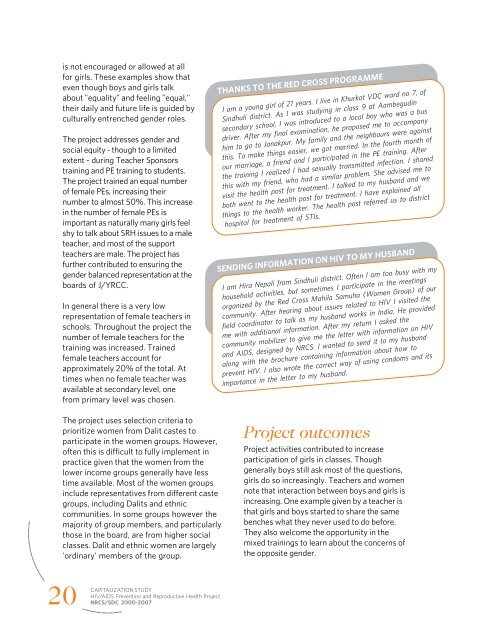HIV/AIDS Prevention & Reproductive Health Project
HIV/AIDS Prevention & Reproductive Health Project
HIV/AIDS Prevention & Reproductive Health Project
Create successful ePaper yourself
Turn your PDF publications into a flip-book with our unique Google optimized e-Paper software.
is not encouraged or allowed at all<br />
for girls. These examples show that<br />
even though boys and girls talk<br />
about "equality" and feeling "equal,"<br />
their daily and future life is guided by<br />
culturally entrenched gender roles.<br />
The project addresses gender and<br />
social equity - though to a limited<br />
extent - during Teacher Sponsors<br />
training and PE training to students.<br />
The project trained an equal number<br />
of female PEs, increasing their<br />
number to almost 50%. This increase<br />
in the number of female PEs is<br />
important as naturally many girls feel<br />
shy to talk about SRH issues to a male<br />
teacher, and most of the support<br />
teachers are male. The project has<br />
further contributed to ensuring the<br />
gender balanced representation at the<br />
boards of J/YRCC.<br />
In general there is a very low<br />
representation of female teachers in<br />
schools. Throughout the project the<br />
number of female teachers for the<br />
training was increased. Trained<br />
female teachers account for<br />
approximately 20% of the total. At<br />
times when no female teacher was<br />
available at secondary level, one<br />
from primary level was chosen.<br />
THANKS TO THE RED CROSS PROGRAMME<br />
I am a young girl of 21 years. I live in Khurkot VDC ward no 7, of<br />
Sindhuli district. As I was studying in class 9 at Aambegudin<br />
secondary school, I was introduced to a local boy who was a bus<br />
driver. After my final examination, he proposed me to accompany<br />
him to go to Janakpur. My family and the neighbours were against<br />
this. To make things easier, we got married. In the fourth month of<br />
our marriage, a friend and I participated in the PE training. After<br />
the training I realized I had sexually transmitted infection. I shared<br />
this with my friend, who had a similar problem. She advised me to<br />
visit the health post for treatment. I talked to my husband and we<br />
both went to the health post for treatment. I have explained all<br />
things to the health worker. The health post referred us to district<br />
hospital for treatment of STIs.<br />
SENDING INFORMATION ON <strong>HIV</strong> TO MY HUSBAND<br />
I am Hira Nepali from Sindhuli district. Often I am too busy with my<br />
household activities, but sometimes I participate in the meetings<br />
organized by the Red Cross Mahila Samuha (Women Group) of our<br />
community. After hearing about issues related to <strong>HIV</strong> I visited the<br />
field coordinator to talk as my husband works in India. He provided<br />
me with additional information. After my return I asked the<br />
community mobilizer to give me the letter with information on <strong>HIV</strong><br />
and <strong>AIDS</strong>, designed by NRCS. I wanted to send it to my husband<br />
along with the brochure containing information about how to<br />
prevent <strong>HIV</strong>. I also wrote the correct way of using condoms and its<br />
importance in the letter to my husband.<br />
The project uses selection criteria to<br />
prioritize women from Dalit castes to<br />
participate in the women groups. However,<br />
often this is difficult to fully implement in<br />
practice given that the women from the<br />
lower income groups generally have less<br />
time available. Most of the women groups<br />
include representatives from different caste<br />
groups, including Dalits and ethnic<br />
communities. In some groups however the<br />
majority of group members, and particularly<br />
those in the board, are from higher social<br />
classes. Dalit and ethnic women are largely<br />
'ordinary' members of the group.<br />
<strong>Project</strong> outcomes<br />
<strong>Project</strong> activities contributed to increase<br />
participation of girls in classes. Though<br />
generally boys still ask most of the questions,<br />
girls do so increasingly. Teachers and women<br />
note that interaction between boys and girls is<br />
increasing. One example given by a teacher is<br />
that girls and boys started to share the same<br />
benches what they never used to do before.<br />
They also welcome the opportunity in the<br />
mixed trainings to learn about the concerns of<br />
the opposite gender.<br />
20<br />
CAPITALIZATION STUDY<br />
<strong>HIV</strong>/<strong>AIDS</strong> <strong>Prevention</strong> and <strong>Reproductive</strong> <strong>Health</strong> <strong>Project</strong><br />
NRCS/SDC 2000-2007

















